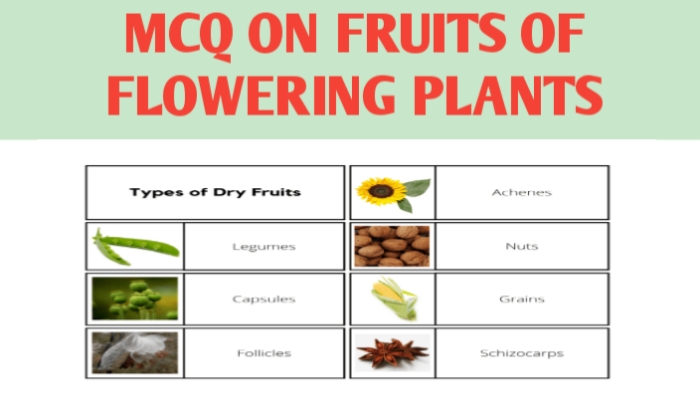MCQ ON FRUITS OF FLOWERING PLANTS class 11 for NEET | FRUITS of flowering plant class 11 MCQ | FRUITS of Flowering plants with Answer | Check the below NCERT MCQ question for class 11 Biology chapter 5 based on FRUITS OF FLOWERING PLANTS with Answers.

MCQ ON FRUITS OF FLOWERING PLANTS
MCQ on FRUITS of Flowering Plants class 11 Biology with answers were prepared based on the latest pattern.We have provided class 11 Biology MCQs questions on FRUITS OF FLOWERING PLANTS with Answers to help students understand the concept very well.
MCQ on FRUITS OF FLOWERING PLANTS is useful for NEET / CSIR / UGC / CBSE / ICSE / AIIMS / EXAM / AFMC EXAM / STATE LEVEL MEDICAL EXAM 2022-23
Introduction:-
The Fruit is an edible products of the entire gynoecium and any floral part which is sweet , juicy , coloured , aromatic and encloses seeds . The two main categories of fruits :- true fruit and false fruit.The fruit derived from ovary of a flower not associated with any non carpellary part is called a true fruit. We include mango , brinjal , banana , tomato , pea .The fruit develop from the ovary along with the other accessory floral parts is called a false fruit.In apple , fig the main edible part of the fruit is the fleshy receptacle.
MCQ ON FRUITS OF FLOWERING PLANTS class 11 for NEET
1. Fruit is a mature or ripened ovary developed
(a) after fertilisation
(b) before fertilisation
(c) during fertilisation
(d) all the above
Ans (a) after fertilisation
2. If a fruit is formed without fertilisation of the ovary ,it is called a
(a) parthenocarpic fruit
(b) drupe
(c) endocarp
(d) all the above
Ans. (a) parthenocarpic fruit
3. In mango and coconut, the fruit is known as
(a) drupe
(b) cypsela
(c) nut
(d) all the above
Ans. (a) drupe
ALSO READ:-
● YOU CAN WATCH BIOLOGY SIR Youtube channel
4. In apple and fig the main edible part of the fruit is the
(a) dry receptacle
(b) fleshy receptacle
(c) mesocarp
(d) endocarp
Ans.(b) fleshy receptacle
5.In wheat the type of fruit is found in
(a) cypsela
(b) caryopsis
(c) achene
(d) nut
Ans.(b) caryopsis
6. In litchi , chestnut , cashewnut ,the type of fruit is
(a) cypsela
(b) caryopsis
(c) nut
(d) samara
Ans.(c) nut
7. In pea , the type of dry fruit
(a) follicle
(b) legume
(c) siliqua
(d) capsule
Ans.(b) legume
8. The fruit produced from the entire hypanthondium inflorescence
(a) Sorosis
(b) syconus
(c) pome
(d) Berry
Ans.(b) syconus
9. In apple the type of fruit is
(a) pome
(b) drupe
(c) pepo
(d) berry
Ans. (a) pome
10. In brassica , the type of fruit is
(a) legume
(b) follicle
(c) siliqua
(d) capsule
Ans. (c) siliqua
11. In jack fruit , pineapple , mulberry type of fruit found is
(a) Sorosis
(b) syconus
(c) drupe
(d) pome
Ans.(a) sorosis
12. Edible part of mango is
(a) recetacle
(b) epicarp
(c) mesocarp
(d) endocarp
Ans.(c) mesocarp
13. Pineapple fruit is developed from
(a) a multilocular monocarpellary flower
(b) a unilocular polar carpellary flower
(c) a multipistillate syncarpous flower
(d) a cluster of completely borne flowers on a common axis.
Ans.(d) a cluster of completely borne flowers on a common axis.
14. The fruit is chambered , developed from inferior ovary and has seeds with succulent testa in
(a) guava
(b) cucumber
(c) pomegranate
(d) orange
Ans.(c) pomegranate
15. The fleshy receptacle of syconus of fig encloses a number of
(a) berries
(b) mericarps
(c) achenes
(d) samaras
Ans. (c) achenes
16. Aril is the edible part of
(a) apple
(b) litchi
(c) banana
(d) mango
Ans.(b) litchi
17. An example of seed with endosperm , perisperm and caruncle is
(a) coffee
(b) castor
(c) cotton
(d) lily
Ans.(b) castor
18. The mesocarp of coconut is
(a) fleshy
(b) stony
(c) fibrous
(d) milky
And.(c) fibrous
19. The morphological nature of the edible part of coconut is ?
(a) cotyledons
(b) endosperm
(c) pericarp
(d) perisperm
Ans. (b) endosperm
20. A fleshy false fruit which develops from fleshy thalamus .
(a) pome
(b) drupe
(c) syconus
(d) sorosis
Ans.(a) pome







Leave a Comment